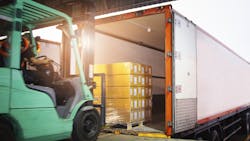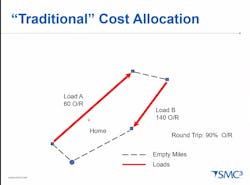As spot rates fall and contract rates are expected to follow suit, proper cost accounting is vital for fleets to remain profitable, according to industry experts. That proper accounting includes revisiting what cost-per-mile actually means.
“The equilibrium between demand and capacity in the truckload industry is generally very short-lived,” said Justin Springer, director of business development SMC3, an LTL logistics company. He spoke during a recent Truckload Carriers Association webinar on accounting during truckload market volatility.
“It seems like we swing from an environment where there’s much more demand than capacity available, and then we see this shift either in carrier investment or procurement of assets or drivers, and the pendulum swings and that equilibrium is usually in balance for a very short period of time.”
See also: TCA’s new leader brings outsider and insider perspectives to industry group
Springer noted that spot market rates have fallen about 14% since January, and contract rates are expected to follow suit. Additionally, he noted that COVID-era spending was heavily weighted toward physical goods as people were stuck at home, but consumers have begun spending more heavily on the service economy now that restaurants, concerts, and other in-person experiences have become more widely safe and accessible.
Accounting by round trip, not by haul
Many carriers have traditionally used an operational model where the profitability of individual loads is based heavily on the average cost per mile. This is an oversimplification, Springer said.
“Carriers that use averages or too much of a historical view of what has looked right,” Springer said, “versus really drilling down and applying the cost appropriately, tend to have challenges. Loads need to be tied to the activities that move them specifically.”
Cost accounting should be based upon the profitability of round trips, not segmented by each haul, Springer said. Carriers need to optimize their routes so that, as a truck leaves and returns to its domicile—such as a terminal or drop yard–the revenue contribution of each haul on the trip is accounted for when determining overall profitability.
See also: Saving costs when sourcing parts
Using an analogy from manufacturing, Springer said, “Think of refining sheet metal or something like that. Your waste is the shavings when you trim it and it's just it's gone. It's trash, right? Maybe you have some small leftover pieces that are sold for pennies on the dollar.”
“In our industry, we basically assume that your waste on that round trip is your empty miles. Your scrap is your backhauls. You’re still getting something for it.”
Being able to properly account for the costs of individual trips versus general operational expenses requires high shipment visibility and accurate dispatch data.
The importance of data in cost accounting
“How do you know your largest customer is a profitable customer? Well, you don't,” said Dale Yelle, director of TL support services at SMC3. Yelle said that, although a carrier may know their bottom line, they must use data to identify if the profitability is derived from that individual customer or from the lane as a whole.
“What we do is we look at your drivers’ activity in a chronological order so that we know when he leaves home, when he picks up a load, when he unloads, when he just has a stop somewhere, all the way until he gets back home,” Yelle said. “It is important to have good dispatch data. That can make all the difference.”
Springer emphasized the importance of granularity of data usage in a strained market, saying, "Using these cost accounting practices, especially as we go into this deflationary rate environment, should really help, and we do see it help when it comes to resource allocation."
“This isn't the tech industry. This isn't a super high-margin industry. So every dollar that can go to the bottom line is a win.”
About the Author
Scott Keith
Scott Keith is a former fleet owner digital editor, who was on staff from 2022 to 2023.


